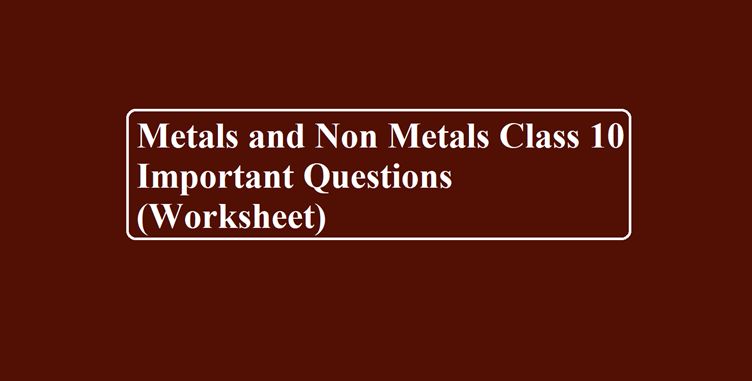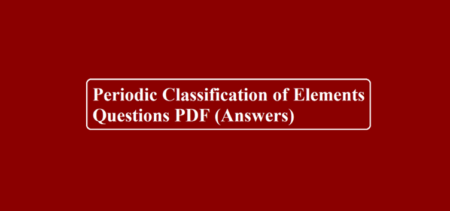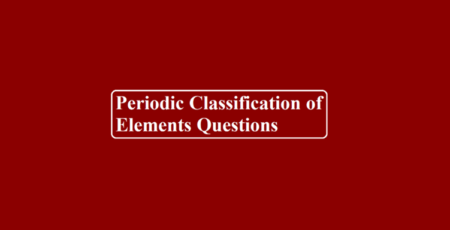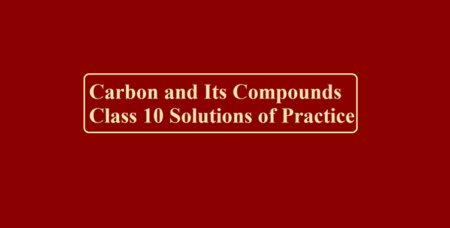Metals and Non Metals Class 10 Important Questions (Worksheet)
Metals and Non Metals Class 10 Important Questions
Que 1. Why does calcium float in water?
Que 2. Name a metal/non-metal
(a) Which makes iron hard and strong?
(b) Which is alloyed with other metals to make amalgam?
(c) Which is used to galvanise iron articles?
(d) Whose articles when exposed to air form a black coating?
Que 3. Why is sodium chloride soluble in water but not in kerosene?
Que 4. A copper plate was dipped into a solution of silver nitrate. After some time a black layer was observed on the surface of the copper plate. State the reason for it and write a chemical equation for the reaction involved.
Que 5. Give reason:
(a) Carbonate and sulphide ores are usually converted into oxides during the extraction of metals.
(b) Ionic compounds generally have a high melting point.
(c) Hydrogen is not metal but has been assigned a place in the reactivity services of metals.
(d) The galvanised iron article is protected against rusting even if the zinc layer is broken.
Que 6. In one of the methods of rust prevention, iron is not coated with anything. Name that method and define it.
Que 7. State four general properties of ionic compounds.
Que 8. Give reasons for the following:
(a) Silver and copper lose their shine when they are exposed to air. Name the substance formed on their surface in each case.
(b) Tarnished copper vessels are cleaned with tamarind juice.
(c) Aluminium is more reactive than iron yet there is less corrosion of aluminium as compared to iron when both are exposed to air.
Que 9. (a) How can the metals at the top of the reactivity series be extracted from their ores? Explain with an example.
(b) Name any one alloy made from
(i) a metal and a non-metal, and
(ii) two metals.
Que 10. (a) The reaction of metal (X) with ferric oxide is highly exothermic. Metal (X) is obtained from its oxides by electrolytic reduction. Identify (X) and write its reaction with ferric oxide.
(b) Give a reason to justify that aluminium oxide is an amphoteric oxide. Also, give another example of amphoteric oxide.
(c) Mention constituent metals present in bronze.
Metals and Non Metals Class 10 Important Questions
Que 11. Which of the following is the correct arrangement of the given metals in ascending order of their reactivity? Zinc, Iron, Magnesium, Sodium
(a) Zinc > Iron > Magnesium > Sodium
(b) Sodium > Magnesium > Iron > Zinc
(c) Sodium > Zinc > Magnesium > Iron
(d) Sodium > Magnesium > Zinc > Iron
Que 12. The electronic configuration of three elements X, Y and Z are X-2,8; Y-2,8,7 and Z-2,8,2 Which of the given is correct?
(a) X is a metal
(b) Y is a metal
(c) Zis a non-metal
(d) Y is a non-metal and Z is a metal
Que 13. What happens when calcium is treated with water?
(a) It does not react with water.
(b) It reacts violently with water.
(c) It reacts less violently with water.
(d) Bubbles of hydrogen gas formed stick to the surface of calcium.
Que 14. Which of the following metal is obtained by the electrolytic reduction process?
(a) Cu
(b) Ag
(c) Fe
(d) Al
Que 15. What happens when dilute sulphuric acid is poured on a silver plate
(a) Silver sulphate is formed
(b) SO2 gas is evolved
(c) No reaction takes place
(d) Hydrogen gas is evolved
Que 16. An aluminium strip is kept immersed in a freshly prepared ferrous sulphate solution taken in a test tube, the change observed is that
(a) Green solution slowly turns brown
(b) Lower end of the test tube becomes slightly warm
(c) A colourless gas with the smell of burning sulphur is evolved
(d) Light green solution changes to blue
Que 17. Which among the following statements is incorrect for magnesium metal?
(a) It burns in oxygen with a dazzling white flame
(b) It reacts with cold water to form magnesium oxide and evolves hydrogen gas
(c) It reacts with hot water to form magnesium hydroxide and evolves hydrogen gas
(d) It reacts with steam to form magnesium hydroxide and evolves hydrogen gas
Que 18. Cinnabar is an ore of which metal?
(a) Tin
(b) Aluminium
(c) Magnesium
(d) Mercury
Que 19. A metal which is exists in a liquid state at room temperature.
(a) Na
(b) Ag
(c) Hg
(d) Au
Que 20. The best conductors of heat are
(a) Silver and Copper
(b) Lead and Mercury
(c) Iron and Tin
(d) Gold and Platinum
Que 21. Electrical wires have a coating of insulating material. The material, generally used is
(a) Sulphur
(b) Graphite
(c) PVC
(d) All can be used
Que 22. Which of the following is not an ionic compound?
(a) Sodium oxide
(b) Carbon tetrachloride
(c) Magnesium chloride
(d) Sodium chloride
Que 23. The nature of metal oxides are
(a) Acidic
(b) Basic
(c)amphoteric
(d) neutral
Que 24. The metals with very low melting points which melts by the temperature of the palm are
(a) Sodium and potassium
(b) Lead and magnesium
(c) Aluminium and zinc
(d) Gallium and caesium
Que 25. Food cans are coated with tin and not with zinc because
(a) Zinc is costlier than tin
(b) Zinc has a higher melting point than tin
(c) Zinc is more reactive than tin
(d) Zinc is less reactive than tin
Que 26. Which metal is associated with haemoglobin?
(a) Calcium
(b) Aluminium
(c) Magnesium
(d) Iron
Que 27. Metallic oxides which react with both acid and base to produce salt and water are called
(a) Neutral Oxides
(b) Basic Oxides
(c) Amphoteric Oxides
(d) Acidic Oxides
Que 28. An electrolytic cell consists of
(i) Positively charged cathode
(ii) Negatively charged anode
(iii) Positively charged anode
(iv) Negatively charged cathode
(a) (i) and (ii)
(b) (iii) and (iv)
(c) (i) and (iii)
(d) (ii) and (iv)
Que 29. Choose the correct option for brass
(a) Cu-Hg
(b) Cu-Mg
(c) Cu-Fe
(d) Cu-Zn
Que 30. When Calcium reacts with water it starts floating on top of the water because
(a) Bubbles of carbon dioxide formed stick to the surface of the metal
(b) Bubbles of hydrogen formed stick to the surface of the metal
(c) Calcium is lighter than water
(d) None of the above
Que 31. Alloys are homogeneous mixtures of a metal with a metal or non-metal. Which among the following alloys contain non-metal as one of its constituents?
(a) Brass
(b) Bronze
(c) Amalgam
(d) Steel
Que 32. The colour of the Iron(ll) sulphate solution is
(a) Blue
(b) Yellow
(c) Green
(d) Orange
Que 33. Ionic compounds have high melting and boiling points because
(a) Less energy is required to break the strong interionic attraction
(b) A large amount of energy is required to break the interionic attraction
(c) No energy is required
(d) None of the above
Que 34. Which of the following metals exist in their native state in nature?
(i) Cu
(ii) Au
(iii) Zn
(iv) Ag
(a) (i) and (ii)
(b) (ii) and (iii)
(c) (ii) and (iv)
(d) (iii) and (iv)
Que 35. Which of the following elements does not react with cold acid?
(a) Na
(b) Mg
(c) C
(d) Zn
Que 36. The white phosphorus is stored
(a) In the air
(b) In water
(c) In kerosene
(d) In CS2
Que 37. Which of the following oxides may be said to be neutral oxides?
(a) CO
(b) CO2
(c) SO2
(d) SO3
Que 38. A student notices that a new hammer made of iron is shiny while an old one kept in the toolbox for a long has a reddish-brown powder deposit over it. What does the change in colour of the hammer indicate?
(a) Effect of moisture on metals
(b) Iron hammer turns brown after some time
(c) Effects of kept in a box for a longer duration
(d) Iron changes colour when kept with other tools Correct
Que 39. When hydrochloric acid is added to barium hydroxide, a white-coloured compound is formed. Which option gives the complete chemical reaction?
(a) HCl + Ba(OH)2 → BaCl2 + 2HOH
(b) 2HCl + Ba(OH)2 → BaCl2 + 2HOH
(c) 2HCl + Ba(OH)2 → BaH2 + 2HCl + O2
(d) HCl + 2Ba(OH) → 2BaCl2 + 2H2O + O2
Que 40. What happens when a pellet of sodium is dropped in water?
(a) It catches fire and forms oxide.
(b) It absorbs heat and forms oxide.
(c) It catches fire and forms hydroxide.
(d) It absorbs heat and forms hydroxide.
Metals and Non Metals Class 10 Important Question



